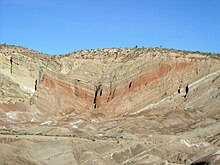
KNOWPIA
WELCOME TO KNOWPIA
Summary
The Barstovian North American Stage on the geologic timescale is the North American faunal stage according to the North American Land Mammal Ages chronology (NALMA), typically set from 16,300,000 to 13,600,000 years BP, a period of 2.7 million years.[1] It is usually considered to overlap the Langhian and Serravallian stages of the Middle Miocene. The Barstovian is preceded by the Hemingfordian and followed by the Clarendonian NALMA stages.


The Barstovian can be further divided into the substages of:
- late Late Barstovian: Lower boundary source of the base of the Langhian (approximate)
- early Late Barstovian: Base of the Langhian (approximate)
- early/lower Barstovian: Upper boundary source: base of Clarendonian (approximate)
Correlations edit
The Barstovian (15.97 to 13.6 Ma) correlates with:
- SALMA
- Colloncuran (15.5-13.8 Ma)[2]
- earliest Laventan (13.8-11.8 Ma)[3]
- ELMA - Astaracian (15.97-11.608 Ma)[4]
- Mammal Neogene Units, European Faunal Zones
- CPS[6]
- earliest Badenian (13.65-12.7 Ma)[7]
- New Zealand stratigraphy - Southland epoch (15.9-10.92 Ma)[8]
- Clifdenian (15.9-13.65 Ma)[9]
- earliest Lillburnian (13.65-12.7 Ma)[10]
- NMAC
References edit
- ^ Paleobiology Database, Barstovian
- ^ Colloncuran at Fossilworks.org
- ^ Laventan at Fossilworks.org
- ^ Astaracian at Fossilworks.org
- ^ MN 5 zone at Fossilworks.org
- ^ Central Paratethys Stages at Fossilworks.org
- ^ Badenian at Fossilworks.org
- ^ Southland epoch at Fossilworks.org
- ^ Clifdenian at Fossilworks.org
- ^ Lillburnian at Fossilworks.org
- ^ Shanwangian at Fossilworks.org
- ^ Tunggurian at Fossilworks.org


